Adrienne Kaplan: ABOUT FACE
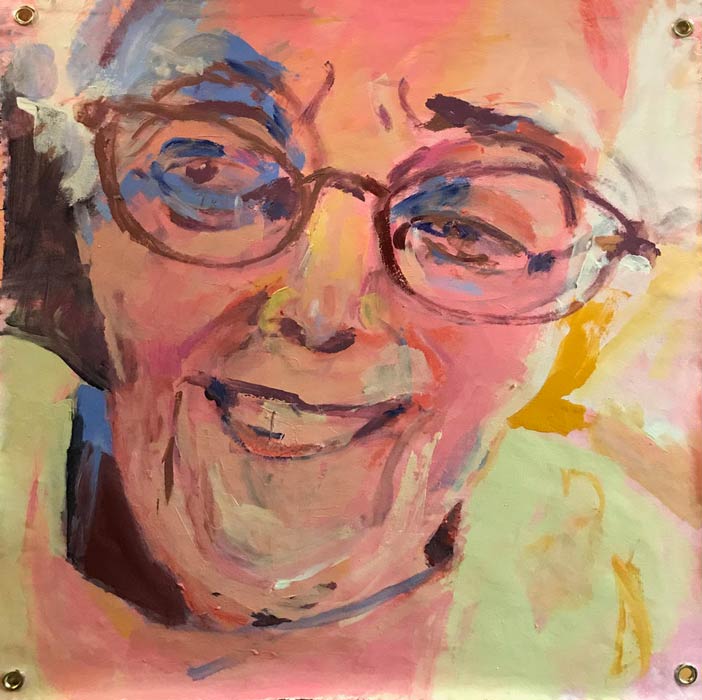
Agk
acrylic on canvas
36 x 36″
Where does a 1950’s, SoCal high school girl go from earning a ‘demerit on your permanent record’ and being subjected to a review of one’s peers for the crime of wearing thongs (the shoe kind) when nylons and shoes are the dress code? Or, (gasp!) wearing a half slip instead of the dress code full slip? Art school, of course!
Adrienne Kaplan says that this experience of wearing what she wanted, regardless of code, was a rare moment of defiance in her early life, but I would argue her paintings are an act of defiance themselves, and probably have been her whole life. Her exuberant use of color and the loose, but studied marks she makes often defy ‘nice’ art making. As a matter of fact, during our recent conversation she said, “I don’t do ‘pretty’ pictures”. But she does do energetic, joyful and fun paintings that capture a sense of immediacy. (If you meet her, you’ll realize that her paintings are the perfect extension of her person.)
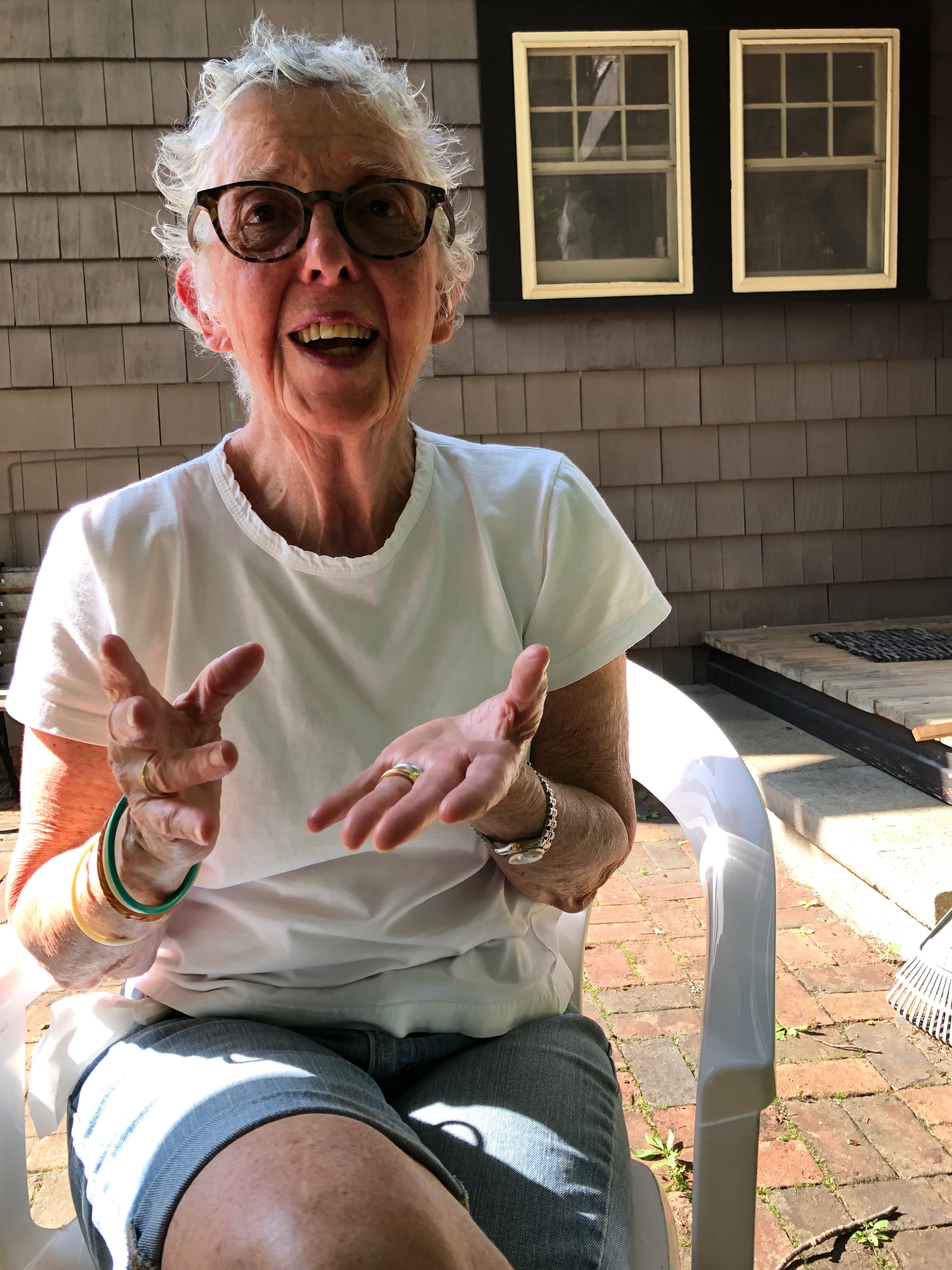
Adrienne Kaplan
July 2019
With Kaplan’s paintings, the viewer gets the sense that this all looks so easy. The informed viewer will realize how just how difficult it is to make something look easy and nonchalant.
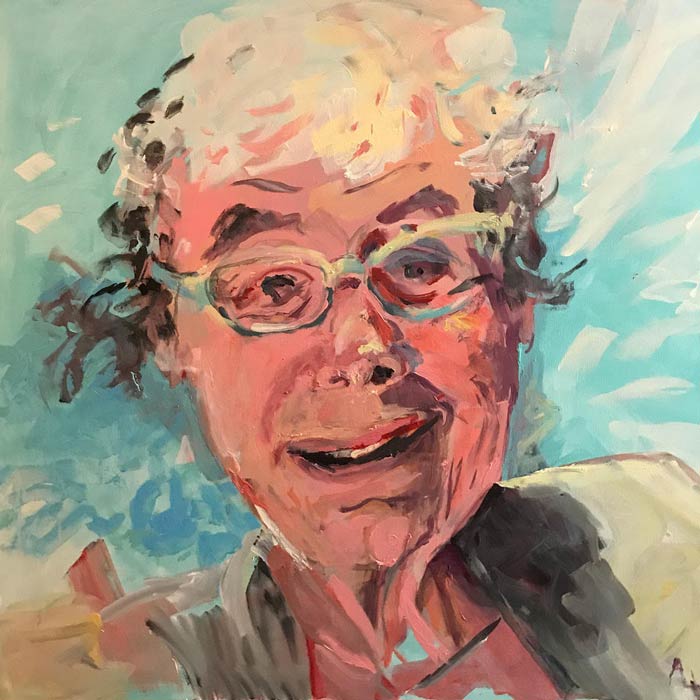
Barbara
acrylic on canvas
36 x 36″
Her confidence in mark making, paint application and color mixing can only be accomplished through a lifetime of work at the easel and of looking at and analyzing paintings and drawings. That’s not to say that every mark and brushstroke of color is made with 100% surety. It is, after all, painting, and things can be covered up. The important thing is, though, as the artist you have to know what to cover up and what to leave.
Kaplan remarked to me that “painting and drawing actually fight with one another”. The rub is about “what color does, as opposed to line”. It brings to mind one of the bits of advice that sticks in my head from art school: “Painting is not drawing with color – we’re building up form with areas of color” (Sarah Krepp, University of Illinois). In conversation with Kaplan, she said nearly the same thing – “I’m building up volume with areas of color.”

containers of mixed acrylic paint in Kaplan’s studio
When two painters get together and the topic of color comes up, I imagine it’s like a couple of scientists talking about the thrill of cell division…or a couple of IT folks talking about Linux or C. We geek out on the effects of color on the eye, or what happens when you put an orange next to a bluish-gray. “What I love about paintings is that I learn. And the more I’m painting, the more I’m learning. Color is such a surprise! (Refer to the orange in the shadow of ‘Widd’, below. One doesn’t normally think of a warm color as a shadow.) Colors create form – they deny drawing, in a way.”
As we continued our geekfest talking about color, Kaplan remarked that she had taken several color theory classes with brilliant teachers over the years – Fred Horowitz, Elaine Wilson, to name a few. Even so, she says ‘color theory’ is too structured. “I’m much too intuitive. I work better when I stumble. When there are rules, it’s no good for me.” (Remember that ‘demerit on the permanent record’?)
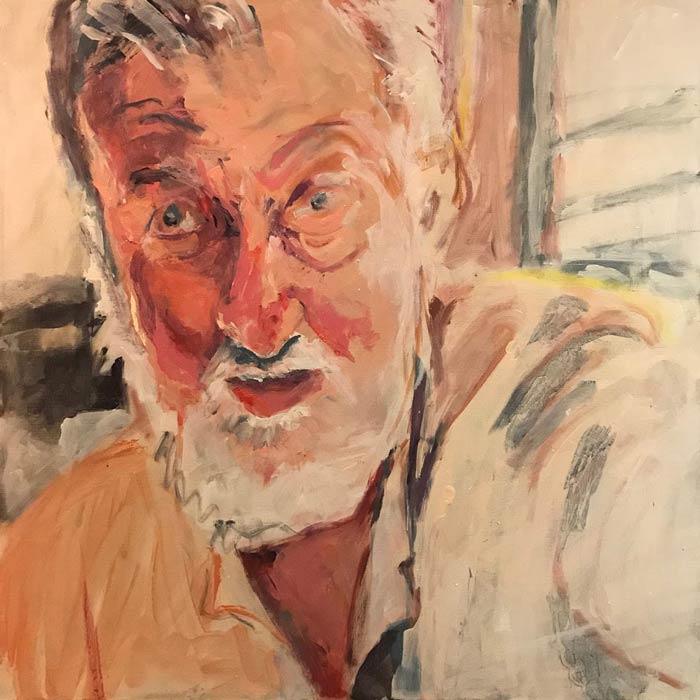
Widd
acrylic on canvas
36 x 36″
Kaplan’s idea for her newest body of work, About Face, on display through the end of August, came about during a visit with her cousin in Palo Alto. She was sitting across from him, thinking about painting the faces of people she knows when the lightbulb went on and she thought ,”yeah, I’m gonna do it.” The only reason there was any hesitation in the first place, was that 3 of the people from her last show hated their portraits! (This led to an interesting discussion between the two of us about candid portraits and our perceptions of ourselves.)
Kaplan has been working on the pieces for this show since November 2018. When I asked her if any of the paintings came easier than others, Kaplan said that some felt like they really flowed -in particular, ‘Widd’ and ‘Barbara’, above.
Kaplan took candid photos of her friends while visiting with them. She said it was difficult to get her subjects to relax for the photos – they felt like they needed to pose. But the candid photos were much more satisfying to paint from than a model sitting live in her studio. Painting is a painstaking process and it’s near impossible to get the candid vitality in a posed portrait that comes from the candid photos.
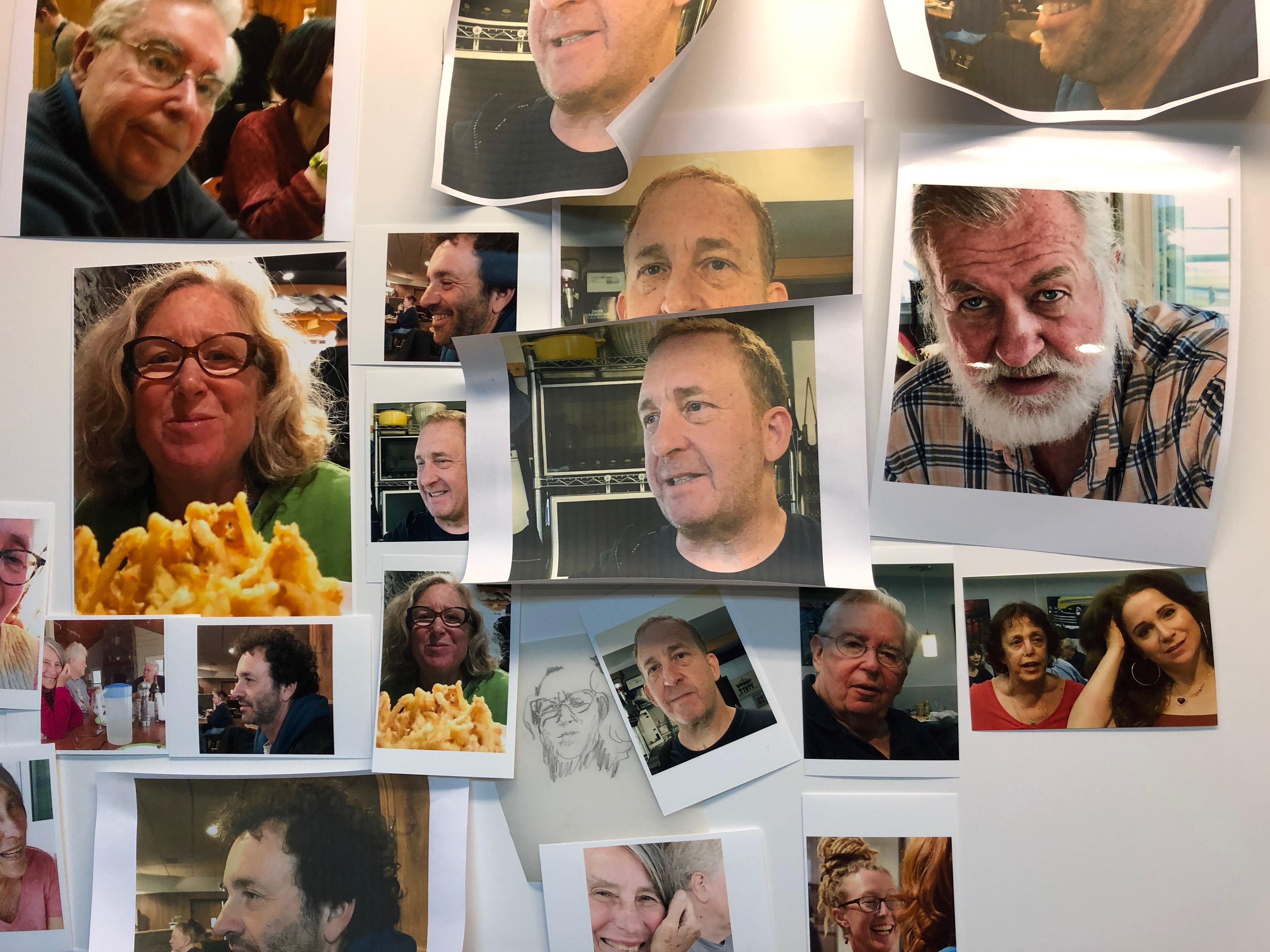
reference photos
Kaplan went to art school at a time when art history teachers prized Greek sculptures over the Roman ones, specifically because the Greek marbles were carved of ‘idealized’ figures. “The figures were more generalized people, not about any specific person,”, Kaplan recalls. “I loved the Roman sculptures because they were portraits of an actual person, capturing something of his/her personality. That’s what I’m going for in these portraits – something particular to that friend or family member.”
When I asked Kaplan to explain a bit about her studio process working up to the paintings, she said, intially, she thought she needed to map out the photographs to the same scale as the paintings, but, after the first one, realized that wasn’t necessary and worked from photos of varying sizes. Also, she made drawing studies on tracing paper over the top of each photo so she could get the eyes and angles right.
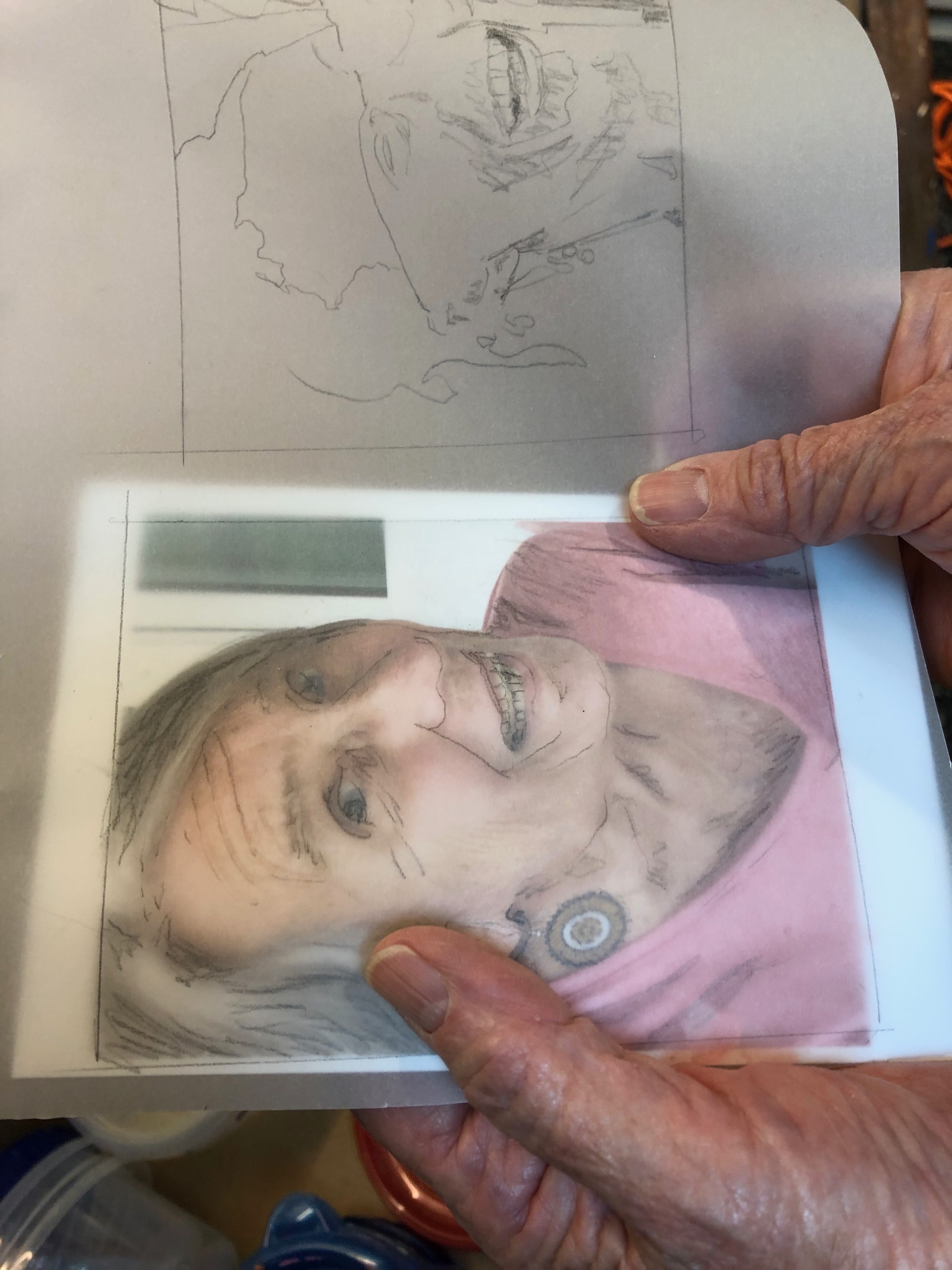
photo with tracing paper drawing superimposed
While I was interviewing Kaplan and learning about her process, her studio mesmerized me. Like most artists I know, she had articles and pictures tacked to the walls around her work space. Some were memorabilia from shows she’d been to, which led to the question about what painters she finds are important to look at. The figures, portraits and technique in Cecily Brown, Jenny Saville and Lucian Freud’s paintings came up as essential to her study. All three are/were British painters.
No doubt about it, these three artists are important to painting. But Adrienne Kaplan is important to painting, too. She brings a joy and passion to her serious pursuit of excellence that’s hard to capture in words. Stop in to the gallery to see how Kaplan combines serious study with exuberant technique in her masterful portraits.
ABOUT FACE is on display through August 31. A poetry reading by Julia Knowlton takes place July 31, 7pm.